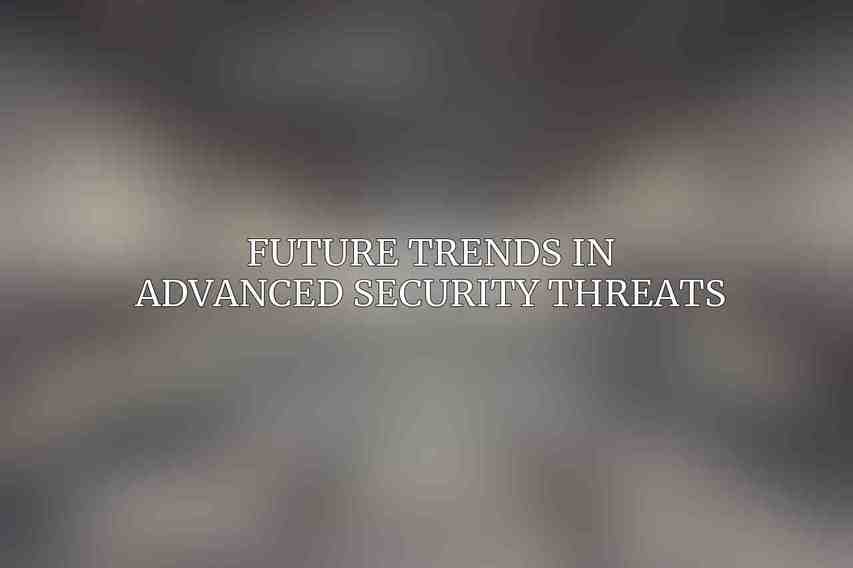advanced security threats continue to pose challenges for organizations worldwide. Advanced security threats encompass a range of sophisticated cyberattacks that target sensitive information, critical infrastructure, and financial resources. These threats go beyond traditional malware and phishing attacks, utilizing advanced tactics and technologies to infiltrate and compromise systems. The significance of emerging threats lies in their ability to bypass conventional security measures, leading to data breaches, financial losses, and reputational damage for organizations. The impact of these threats on organizations can be severe, resulting in operational disruptions, financial penalties, and loss of customer trust.
Advanced Persistent Threats (APTs)
Advanced Persistent Threats (APTs) are a prime example of sophisticated cyber threats that operate stealthily to maintain long-term access to targeted systems. APTs are typically state-sponsored or financially motivated, focusing on espionage, data theft, or sabotage. These threats exhibit persistent and targeted behavior, often leveraging social engineering techniques and zero-day vulnerabilities to gain initial access. Common APT tactics, techniques, and procedures (TTPs) include lateral movement within networks, privilege escalation, and data exfiltration. Mitigating APTs requires a comprehensive approach involving continuous monitoring, network segmentation, access controls, and threat intelligence sharing among organizations.
Latest and Emerging Threats
Several latest and emerging threats are causing concern in the cybersecurity world of 2024. These threats include:- Zero-day exploits: These are unpatched vulnerabilities in software or hardware that attackers exploit before a patch is available, allowing unauthorized access to systems.- Ransomware-as-a-Service (RaaS): RaaS models offer malicious actors the tools and infrastructure to carry out ransomware attacks, encrypting files and demanding payment for decryption.- Supply chain attacks: By compromising trusted third-party software or services, attackers can infiltrate target organizations through trusted channels, leading to widespread impact.- Cloud and infrastructure attacks: Targeting cloud platforms and critical infrastructure systems can result in service disruptions, data theft, and unauthorized access.- IoT and connected device vulnerabilities: Security flaws in Internet of Things (IoT) devices and connected systems can be exploited to launch large-scale attacks or intrusions into networks.
Advanced Evasion Techniques

Advanced evasion techniques are employed by threat actors to avoid detection and bypass security controls. These techniques include:- Fileless malware: Malware that executes in memory without leaving traces on the disk, making detection challenging for traditional antivirus solutions.- Obfuscation and encryption: Techniques used to hide malicious code from security tools by encrypting or altering the code structure.- Anti-forensics and anti-debug techniques: Measures that hinder post-incident investigations by erasing traces of the attack or disrupting analysis processes.
Preparation and Mitigation Strategies
Organizations need to adopt proactive strategies to defend against advanced security threats effectively. These strategies include:- Threat intelligence: Continuously monitoring the threat world and analyzing trends to anticipate and prevent potential attacks.- Security awareness training: Educating employees about emerging threats, social engineering tactics, and the importance of cybersecurity best practices.- Multi-layered security architecture: Implementing a combination of preventive, detective, and responsive security controls to defend against diverse attack vectors.- Vulnerability management: Regularly assessing and patching vulnerabilities in software, systems, and devices to mitigate potential exploitation.- Incident response plan: Establishing well-defined procedures and protocols to detect, respond to, and recover from security incidents efficiently.
Future Trends in Advanced Security Threats

Looking ahead, several trends are expected to shape the world of advanced security threats in the near future. These trends include:- Rise of artificial intelligence (AI) in threat detection and attack execution: AI-powered tools are increasingly being leveraged by both attackers and defenders, leading to a more dynamic and automated threat world.- Increased targeting of cloud-based services and data: As organizations embrace cloud technologies, cybercriminals are focusing their efforts on exploiting cloud infrastructure and services for data theft and disruption.- Evolution of ransomware and extortion techniques: Ransomware attacks are evolving to involve data theft, extortion, and reputation damage, requiring organizations to enhance their ransomware preparedness strategies.- Emergence of quantum computing and its impact on cryptography: The rise of quantum computing poses challenges to traditional cryptographic methods, necessitating the development of quantum-resistant encryption standards.
the emergence of advanced security threats in 2024 underscores the importance of proactive cybersecurity measures and continuous adaptation to evolving threats. Organizations must prioritize security investments, employee training, and threat intelligence sharing to stay ahead of sophisticated adversaries. Collaboration and information sharing among organizations are crucial in building a resilient cybersecurity ecosystem that can effectively combat advanced security threats and safeguard digital assets. Staying vigilant and proactive in the face of these emerging threats is paramount for organizations seeking to protect their data, operations, and reputation in an increasingly connected and vulnerable digital world.
Frequently Asked Questions
1. What are some examples of emerging advanced security threats in the year 2024?
Some examples of emerging advanced security threats in 2024 may include AI-powered cyber attacks, quantum computing attacks, deepfake technology for manipulation and social engineering, and supply chain vulnerabilities. Check out our insights into Best Security Solutions for E-commerce 2024 Dive deeper into Top Encryption Software Reviewed for 2024
2. How can companies prepare themselves to tackle these advanced security threats?
Companies can prepare themselves by investing in robust cybersecurity measures, educating employees on cybersecurity best practices, implementing multi-factor authentication, conducting regular security audits, and staying informed about the latest threats and trends in the cybersecurity world.
3. Is there a particular industry or sector that is more vulnerable to these emerging advanced security threats?
While every industry is vulnerable to emerging advanced security threats, industries such as finance, healthcare, and government agencies are particularly targeted due to the sensitive nature of the data they deal with.
4. How can individuals protect themselves from these advanced security threats in their personal lives?
Individuals can protect themselves by using strong and unique passwords for each online account, enabling two-factor authentication, being cautious of phishing emails and suspicious links, keeping their software and devices updated, and being vigilant about their online privacy.
5. Are there any technological advancements that can help in mitigating these emerging security threats?
Technological advancements such as artificial intelligence-powered cybersecurity solutions, blockchain technology for secure transactions, biometric authentication methods, and cloud-based security services can help in mitigating emerging advanced security threats in 2024.

